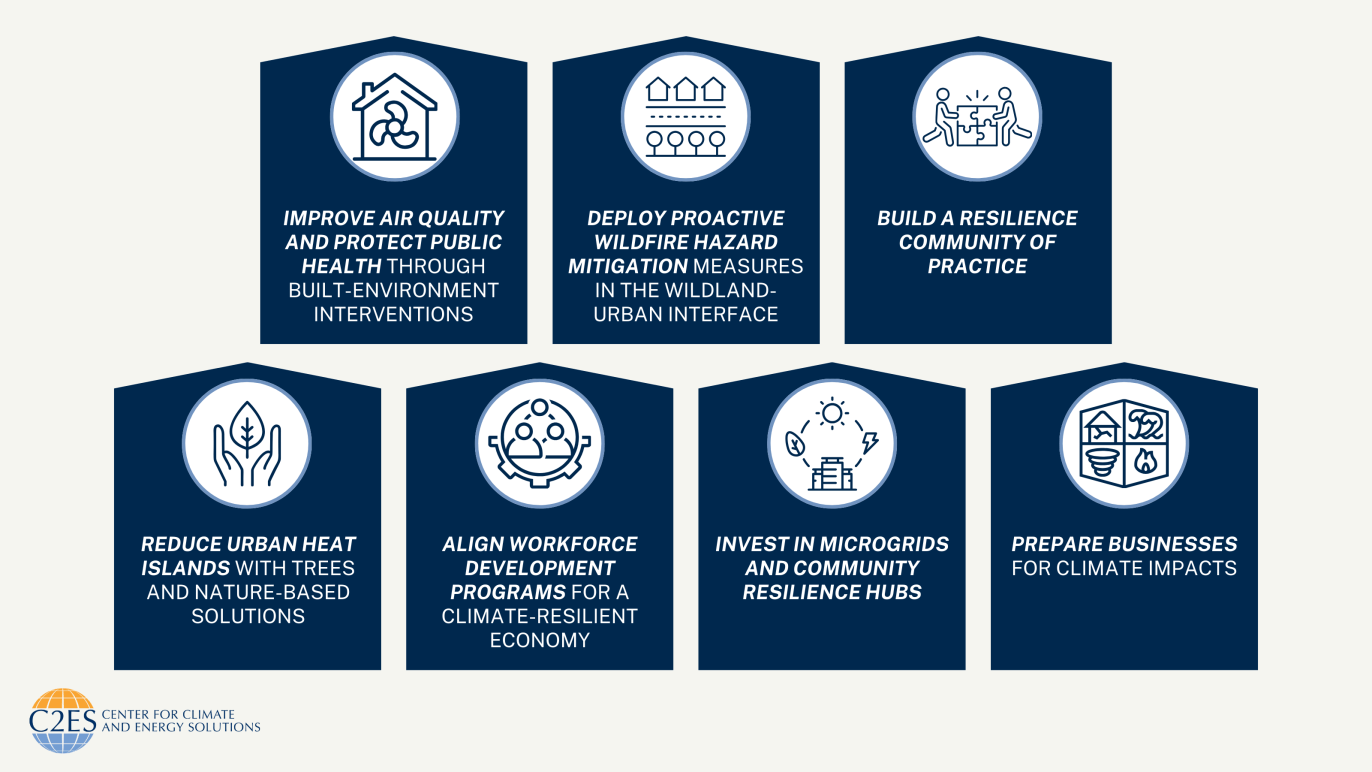Following a summer marked by wildfire-fueled hazy skies and poor air quality and 28 billion-dollar disasters (the most in a single year), building resilience to climate impacts is becoming a greater concern for communities across the country. Before 2023 was declared the warmest year on record, the U.S. Fifth National Climate Assessment (NCA5) called for “transformative adaptation” to realize future social and economic prosperity.
In step with NCA5’s recommendations for collaboration across sectors, participatory planning, and aligned funding, C2ES launched the first Climate Resilient Communities Accelerator to accelerate regional action on wildfire and heat in the North Front Range of Colorado.
The Accelerator’s recent events in Colorado convened an array of leaders across local governments, private businesses, economic development, community-based organizations, and federal and state agencies, to share impacts and goals, identify key action areas, and connect with public and private sector resources to accelerate action, in partnership with Colorado State University’s Climate Adaptation Partnership.
C2ES chose the North Front Range—generally defined as the corridor between Fort Collins and Denver—after communities and partners applied to host the pilot Accelerator. Colorado experiences more than 2,400 wildfires each year and recent climate projections show increasing risk alongside warmer and drier air. In 2020, the state suffered its three largest fires, and in 2021, the Marshall Fire caused more than $2 billion in damages and destroyed more than 1,000 homes and businesses in the Front Range, which is at particular risk of wildfire due to high housing density in the Wildland Urban Interface (WUI).
Identifying Key Action Areas
Through the Accelerator convenings, a diverse set of leaders identified and explored seven key action areas to advance the North Front Range’s resilience to wildfire and heat. These areas cover a range of crucial resilience components and can serve as a roadmap moving forward.

These areas—ranging from improving air quality and health equity to investing in microgrids and community resilience hubs—serve as strategies that can reduce the impacts of multiple climate hazards and will require action from a diverse set of actors to succeed.
Defining a resilient future in the North Front Range
The Accelerator’s first event in Fort Collins, a Climate Resilient Economies Roundtable focused on the physical impacts of wildfire and heat and opportunities to accelerate action toward long-term climate and economic resilience in the region.
Participants shared their visions for a prosperous and resilient future in the North Front Range, which were characterized by healthy, connected, diverse, and inclusive communities with affordable housing, thriving natural systems, and diverse partnerships.
However, common challenges also surfaced across our discussions on regional resilience strategies, including the need to increase capacity to act at the local level, overcome the complexity of federal grants, and leverage more cross-sectoral partnerships.
Resources to accelerate resilience
An increasing amount resiliency resources are available across federal and state agencies and the private sector. To shorten the distance between these resources and practitioners throughout the region, the Accelerator’s second event in Denver, a Resources Connector Forum, featured agencies and businesses that could help address common challenges and support the 7 key action areas.
Accelerator participants collaborated with business leaders from AT&T, Vaisala, and Xcel Energy and made valuable connections with regional leads at the Federal Emergency Management Administration (FEMA), National Oceanic and Atmospheric Administration (NOAA), U.S. Department of Energy (DOE), U.S. Economic Development Administration (EDA), and U.S. Housing and Urban Development (HUD).
Private businesses are learning they have a role in building local resilience
Local businesses also have a stake in—and interest in building—the capacity for communities to withstand growing climate impacts. For example, telecommunications companies like AT&T play important roles before, during, and after a natural disaster, including coordinating emergency response and communications between affected communities. AT&T started working with Argonne National Laboratory to better understand climate-related risk across its operations and prioritize improvements.
When AT&T realized that the neighborhood-level climate data that guides its own resilience-building efforts could help communities as well, the company and Argonne teamed up with FEMA to build the Climate Risk and Resilience Portal (ClimRR), a free tool with forward-looking, actionable data about future climate hazards such as temperatures and heat, wildfire risk, rainfall, and wind speeds. ClimRR is designed to help communities, businesses, government entities and others better understand and address future climate threats. For example, AT&T assisted Idaho’s Office of Emergency Management with integrating ClimRR’s forward-looking climate data into the state’s new Hazard Mitigation Plan.
A path forward
With the engagement and leadership from public, private, and community stakeholders, the Climate Resilient Communities Accelerator is beginning to outline a path forward for the region. In 2024, C2ES will build on this progress with a diversity of regional stakeholders and additional convenings to drive progress in several key action areas.
C2ES will share insights and lessons from the Accelerator convenings to support awareness, alignment, and action across the region, and explore federal grant opportunities and policy needs that could accelerate these efforts in the North Front Range and beyond.
C2ES launched the 2023 Climate Resilient Communities Accelerator with the generous support of the Bank of America Charitable Foundation.

